SC Rewind: 75 Years Ago
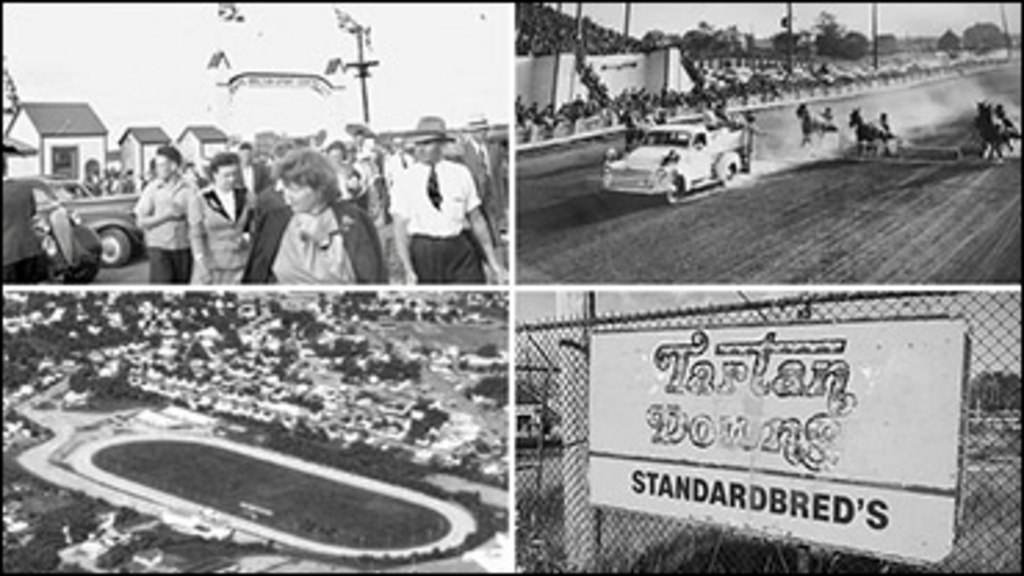
In this week's Rewind Robert Smith recalls a time long ago when a very small track in far off Nova Scotia held a memorable day of racing to christen their new sports facility. August 1, 1945 was a banner day at the newly opened Cape Breton Sports Centre in Sydney as it was then called. It was the dawning of a new age in harness racing for the region and it would grow and prosper in the years ahead.
Seventy-five years ago harness racing in Canada and elsewhere for that matter was at a low ebb. The war years had done much to stifle every aspect of the sport. Many young participants had enlisted in the services and most had gone to join the war effort. As time went on in the years between 1939 and 1945, the toll became greater and those left to "keep the home fires burning" were growing weary. One small community with a long history involving the harness sport was determined to not sit by idly and be overtaken by complacency.
Special note - I am indebted to Mr. Paul MacDougall for the great research he did that aided in compiling today's column. His intensive work led to a story that was published in The Cape Breton Post on October 5, 2019. I have reprinted the story with his permission. He also provided a number of excellent photos that depict the times.
GONE BUT NOT FORGOTTEN by Paul MacDougall
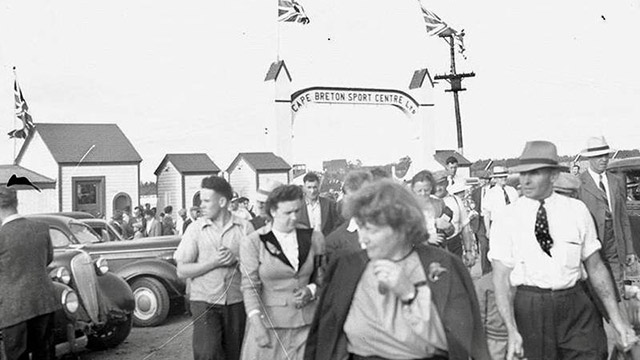
A large crowd exits the Cape Breton Sports Centre in this old photo from around 1946. (Contributed/Beaton Institute Reference No. 329.4 - Beaton Institute, Cape Breton University)
By the time the 1930s came around, harness racing — which was the main horse racing in Cape Breton — had come into its own in Sydney. It rivalled boxing for the number of people involved and was growing. But the Second World War and fading interest pulled the reins tight on the sport for a while.
As the war dragged on, many small communities countrywide were looking for ways to get their returning young men — many scarred and wounded by the war — plus families in general, back on a normal track. In Sydney that normal track was literally a track, the old Trotting Park was to be converted into a modern sports facility — the Cape Breton Sports Centre. The notion for a new sports centre began in 1944 with a group of citizens and business people from Sydney led by Gordon Elman. Sources indicate the original Sydney Trotting Park track opened on the same site in 1899.
The $75,000 needed to finance the project was raised by canvassing the local community, which was not adverse to this type of project. Citizens of Sydney had previously helped fund the Isle Royale Hotel as well as community rinks.
By July 1945, the Cape Breton Sports Centre (renamed Tartan Downs in 1984) was near completion and “unanimously regarded as one of the finest in Canada.” Harness racers from the local area were so excited and enthusiastic about the new sports centre they had begun to buy new horses from Quebec and Ontario. The Sydney Post-Record reported, “One local sportsman has invested $5,000 in a reputed elegant piece of horseflesh which he is bringing here via express.”
Forty brand new stables (20 winterized) were built to the left of the Prince Street entrance near a new paddock area where the drivers could exercise their mounts. A new canopy grandstand seating area that could accommodate 2,400 was built. Those who choose not to pay the extra 35 cents for seating could watch from the large paddock area or anywhere along the railing.
A movable stand for the starter, judges, race officials and three microphone hookups was built. Everything was painted in a splashy red and white pattern. Three ticket stands were designed, two for pedestrians and a separate one for cars, that could drive right into the grounds in a huge 1,000-vehicle parking lot for a cost of 25 cents. A baseball diamond was built in the inner circle of the track. The half-mile oval itself was created by P.E.I. master turf builder Joe O’Brien. In mid-July, the oval was finished and tested by horsemen.
“Veteran horsemen and railbirds unanimously agree it is the ‘fastest track in the Maritimes,’” reported the Post-Record. Such was the importance of the new facility, Sydney City Council under Mayor Jack MacLean, declared the day the Cape Breton Sports Centre opened, Aug. 1, 1945, a civic holiday. An official public welcome for Sydney’s returned soldiers was part of the opening ceremonies.
On the morning of the opening, wounded veterans unable to walk gathered at the Dorchester Street legion and were driven in cars to the Ashby baseball field, accompanied by three marching bands. At the ballfield they were joined by many walking veterans who marched up to the new sports centre where they were greeted by close to 10,000 people estimates say. Upwards of 400 veterans were given illuminated scrolls by the Mayor and council members.
A large afternoon of racing followed. In the evening a talent show, a community singsong led by George (Thumper) MacDonald, a band concert and fireworks capped off the night. These were the first fireworks set off in Sydney since Old Home Week of 1935.
A highlight of the harness racing card featured retired Royal Canadian Air Force Flight Lt. Pat Cadegan Jr., who drove his own horse. Daring, fast and risky as harness racing is, it was a far cry from piloting a huge Lancaster Bomber on 63 missions over Germany for which Cadegan Jr. won the Distinguished Flying Cross.
Paul MacDougall is a local writer and senior instructor in health studies at Cape Breton University.
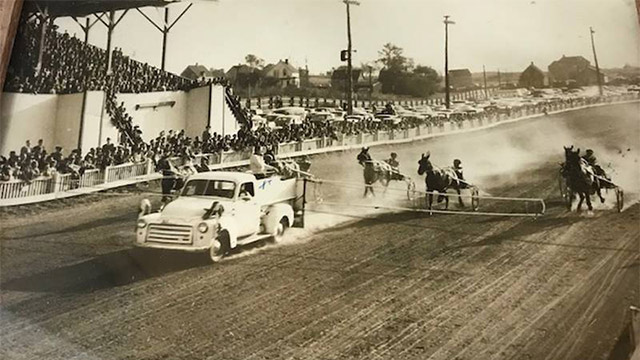
Above is a view of the Sydney Track taken during the early years. A view of the huge crowd and full parking lot was an indication of the popularity of this location. (Photo courtesy of Paul MacDougall)
THE FIRST DAY
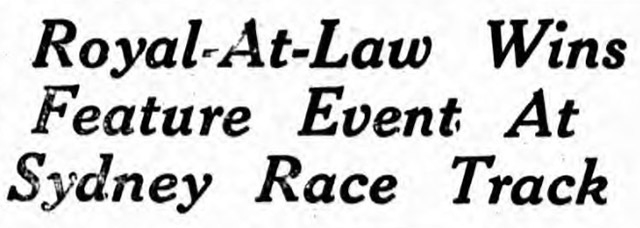
On Wednesday August 1, 1945 the new racing centre held its inaugural card of racing much to the delight of everyone concerned. It marked the first time in 10 years that a race day had been held at this location. It was followed by six more race days that year, with the final card held on October 20th. On that first afternoon at the newly revamped facility, a total of 33 horses were entered in four different events. In all 13 heats were held, all keenly contested. Purses totalling $1,400 were up for grabs which was excellent for that time.
The driving star of the afternoon was local horseman George Lewis, who made five visits to the winner's circle. His wins were achieved in two races where he won all three heats in one event behind Grace Abbey and two in another driving Pearl Bumpas. Another three-heat winner was a horse named Dr. L.B. (C. Sweet driver) owned by Sylvester Phalen of Glace Bay, N.S. The featured event of the day with a purse of $500 was won by a visiting horse Royal-At-Law owned by Heber Sweeney of Bridgewater, N.S. and driven to a three-heat victory by Frank McAlduff. A report of the race day distributed by the Canadian Press said "The winning horse kicked dust in the face of a strong field to romp home first in all three heats of the Free For All." The same account also stated "The crowd attending was one of the largest in Cape Breton sporting history."
The winning time of 2:10 1/2 by Royal-At-Law was the fastest of the day and just one second short of the existing track record set here 10 years earlier. Old statistics are hard to find but I believe Toll Gate held the existing track record. Ironically that great horse was also owned by this day's winner. Mr. Sweeney was highly regarded in the area and at one time was Mayor of Bridgewater.
Harness racing was a much loved pastime in this area of the country with another track located at North Sydney, some 20 miles away. In October 2019, the property long occupied by the Cape Breton Sports Centre which closed in 2006 was sold to Cape Breton University for future development. The track located at North Sydney is still in existence and holds racing during the summer months each year.
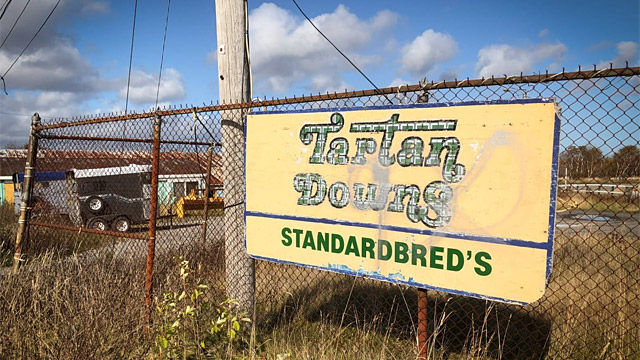
In its heyday, Tartan Downs was popular with horse owners, drivers and spectators, but gambling competition and the closure of Cape Breton's steel plant and coal mines hurt the business. (Tom Ayers/CBC)
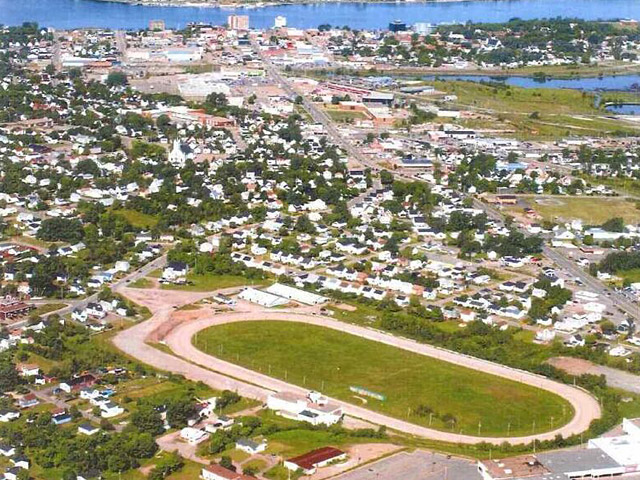
An undated aerial view of The Cape Breton Sports Centre and surrounding area which later became Tartan Downs
Quote For The Week: "Some people are like blisters. They show up only after all of the work is done."
Who Is It?
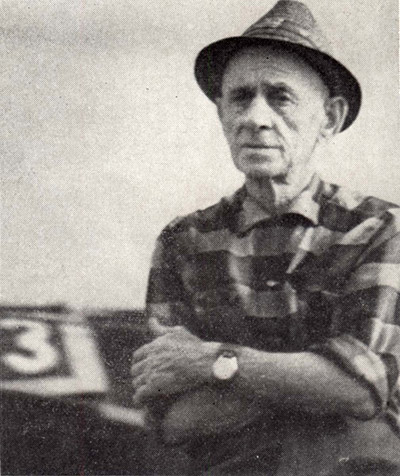
Can you identify this man who was long associated with Maritime harness racing? (Hoof Beats photo)
Who Else Is It?
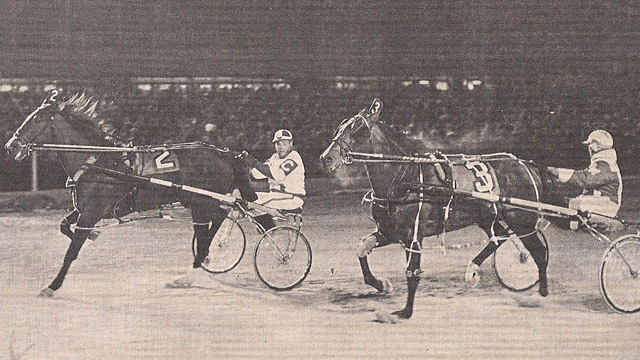
Can you identify the winning driver (2) in this picture? If you have a really keen eye who is finishing second?


This week's pictures were
This week's pictures were once again correctly identified. In the top photo was legendary Maritime horseman Johnny Conroy. In the lower picture it was Jack Campbell driving Derbys Gent to a victory over Piper Wall with Dave Wall up. That was from 1975. Thanks again.
Jack Campbell with Derby’s
Jack Campbell with Derby’s Gent and Dave Wall with Piper Wall.
Thanks for the great story on
Thanks for the great story on Sydney. My grandfather raced against horses owned by Heber Sweeney. The Who is it picture is Johnny Conroy one of the greatest trainer drivers ever in the Atlantic Provinces. He was at the top of his game when he raced against Joe O'Brien in the 1940's. I met Mr. O'Brien at Goshen in 1965 and the first question he asked me was how is Johnny Conroy. He was well respected and had a great career. Regards, Bert Clish
Could it be jack campbell and
Could it be jack campbell and dave wall?
Who Else? Jack Campbell
Who Else? Jack Campbell winning with Ron Waples second.
Who Is It Picture, Johnny
Who Is It Picture, Johnny Conroy.
who else is it? Jack Campbell
who else is it? Jack Campbell and Ron Waples!!! Enjoy the history of racing, but 1945 was my 1st year!!
Jack Campbell, Dave Wall.
Jack Campbell, Dave Wall.